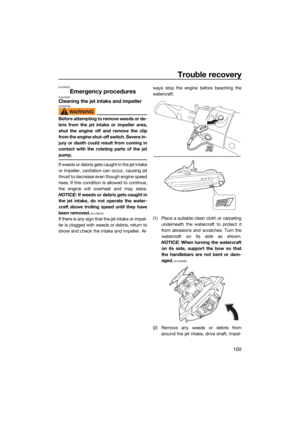Page 105 of 116
Trouble recovery
98
Engine runs irregu-
larly or stallsFuel Fuel tank empty Refill as soon as pos-
sible57
Stale or contaminat-
ed Have serviced by
Yamaha dealer
—
Fuel tank Water or dirt present Have serviced by Yamaha dealer—
Spark plug Fouled or defective Have serviced by Yamaha dealer—
Incorrect heat range Have serviced by Yamaha dealer —
Gap incorrect Have serviced by Yamaha dealer —
Electrical wir-
ing Loose connection Have serviced by
Yamaha dealer —
Fuel injec-
tion system Faulty or clogged in-
jectors Have serviced by
Yamaha dealer
—
Warning is dis-
played Fuel level
warningFuel tank empty Refill as soon as pos-
sible 57
Oil pressure
warning Oil pressure dropped Have serviced by
Yamaha dealer 48
Engine over-
heat warning Jet intake clogged Clean
100
Check en-
gine warning Faulty sensors Have serviced by
Yamaha dealer 47
TROUBLE POSSIBLE CAUSE REMEDY PAGE
UF3V72E0.book Page 98 Tuesday, June 16, 2020 2:29 PM
Page 106 of 116
Trouble recovery
99
Watercraft slow or
loses powerWatercraft
operation
modeDrive control mode
activated
Deactivate or adjust
drive control mode 36
Cavitation Jet intake clogged Clean 100 Impeller damaged or
worn Have serviced by
Yamaha dealer
100
Engine over-
heat warning Engine speed reduc-
tion control activated Clean jet intake and
cool engine
47
Oil pressure
warning Engine speed reduc-
tion control activated Add oil
48
Spark plug Fouled or defective Have serviced by Yamaha dealer—
Incorrect heat range Have serviced by Yamaha dealer —
Gap incorrect Have serviced by Yamaha dealer —
Electrical wir-
ing Loose connection Have serviced by
Yamaha dealer —
Fuel Stale or contaminat- ed Have serviced by
Yamaha dealer
—
Air filter Clogged Have serviced by Yamaha dealer—
Oil buildup Have serviced by Yamaha dealer —
Throttle lever Faulty Have serviced by Yamaha dealer—
TROUBLE POSSIBLE CAUSE REMEDY PAGE
UF3V72E0.book Page 99 Tuesday, June 16, 2020 2:29 PM
Page 107 of 116

Trouble recovery
100
EJU34625
Emergency proceduresEJU44590Cleaning the jet intake and impellerEWJ00783
Before attempting to remove weeds or de-
bris from the jet intake or impeller area,
shut the engine off and remove the clip
from the engine shut-off switch. Severe in-
jury or death could result from coming in
contact with the rotating parts of the jet
pump.
If weeds or debris gets caught in the jet intake
or impeller, cavitation can occur, causing jet
thrust to decrease even though engine speed
rises. If this condition is allowed to continue,
the engine will overheat and may seize.
NOTICE: If weeds or debris gets caught in
the jet intake, do not operate the water-
craft above trolling speed until they have
been removed.
[ECJ00654]
If there is any sign that the jet intake or impel-
ler is clogged with weeds or debris, return to
shore and check the intake and impeller. Al- ways stop the engine before beaching the
watercraft.
(1) Place a suitable clean cloth or carpeting
underneath the watercraft to protect it
from abrasions and scratches. Turn the
watercraft on its side as shown.
NOTICE: When turning the watercraft
on its side, support the bow so that
the handlebars are not bent or dam-
aged.
[ECJ02690]
(2) Remove any weeds or debris from around the jet intake, drive shaft, impel-
UF3V72E0.book Page 100 Tuesday, June 16, 2020 2:29 PM
Page 108 of 116

Trouble recovery
101
ler, jet pump housing, and jet thrust noz-
zle.
If debris is difficult to remove, consult a
Yamaha dealer.
EJU43472Raising the reverse gate
If the RiDE system malfunctions and the re-
verse gate remains in the lowered position,
the watercraft will not be able to move for-
ward.
After raising the reverse gate so that the wa-
tercraft can move forward, immediately re-
turn to shore and have a Yamaha dealer
service the watercraft.
To raise the reverse gate:
(1) Stop the engine and remove the clip from the engine shut-off switch.
(2) Enter the water and move to the rear of the watercraft.
(3) Slide the shift rod joint toward the bow, and then disconnect the shift rod joint
from the ball joint. (4) Raise the reverse gate to the forward po-
sition.TIP:
While the shift rod is disconnected, the re-
verse gate will not move to the neutral po-
sition or reverse position even if the RiDE
lever is squeezed.
If the RiDE lever is squeezed while the shift
rod is disconnected, the watercraft will
move forward.
EJU34642Jumping the battery
If the watercraft battery has run down, the en-
gine can be started using a 12-volt booster
battery and jumper cables.
EJU34664Connecting the jumper cablesEWJ01251
To avoid battery explosion and serious
damage to the electrical system:
Do not reverse the polarity of the jumper
cables when connecting to the batter-
ies.
Do not connect the negative (–) jumper
cable to the negative (–) terminal of the
watercraft battery.
Do not touch the positive (+) jumper ca-
ble to the negative (–) jumper cable.
1Shift rod joint
2 Ball joint
1 2
1
Reverse gate
2 Forward position
2
1
UF3V72E0.book Page 101 Tuesday, June 16, 2020 2:29 PM
Page 109 of 116

Trouble recovery
102
(1) Connect the positive (+) jumper cable tothe positive (+) battery terminals of both
batteries.
(2) Connect one end of the negative (–) jumper cable to the negative (–) battery
terminal of the booster battery.
(3) Connect the other end of the negative (–) jumper cable to an engine hanger.
(4) Start the engine, and then disconnect the jumper cables by reversing the steps
above. (See page 26 for information on
starting the engine.)EJU43482Replacing the fuses
If a fuse is blown, replace it with the proper
fuse.
To replace a fuse:
(1) Remove the seats and removable water-tight storage compartment. (See page 49
for seat removal and installation proce-
dures and page 54 for information on the
removable watertight storage compart-
ment.)
(2) While pushing the projection on each lock, slide the locks outward.
1Negative (–) jumper cable
2 Booster battery
3 Positive (+) jumper cable
4 Engine hanger
1
4
3
2
1Good fuse
2 Blown fuse
1 Good fuse
2 Blown fuse
2
1
2
1
UF3V72E0.book Page 102 Tuesday, June 16, 2020 2:29 PM
Page 110 of 116
Trouble recovery
103
(3) Remove the electrical box cover.
(4) While pushing both sides of the fuse boxcover inward, pull the cover toward the
bow and remove it.
(5) When replacing the SCU fuse, remove the screws, and then remove the fuse. Install the spare fuse, and then tighten
the screws.
(6) When replacing a fuse other than the SCU fuse, remove the fuse using the
fuse puller. Install a spare fuse of the
proper amperage. WARNING! Do not
use fuses of a different amperage than
recommended. Substitution with a
fuse that has an improper rating can
cause extensive electrical system
damage and possible fire.
[EWJ00803]
1 Electrical box cover
2 Lock
3 Projection
1 Fuse box cover
2
3
2
3
1
1
1Electronic throttle valve fuse
2 Fuel pump fuse
3 Main relay drive fuse
4 Main fuse
5 Spare fuse
6 Fuse puller
7 Battery fuse
8 Screw
9 SCU fuse (BCU fuse)
10 Unused fuse
1
5
23 4 5 6 7
8
9
8
10
UF3V72E0.book Page 103 Tuesday, June 16, 2020 2:29 PM
Page 111 of 116

Trouble recovery
104
(7) Securely install the fuse box cover in itsoriginal position.
(8) Securely install the electrical box cover in its original position.
(9) Slide the locks to their original positions to securely lock the electrical box cover
in place.
(10) Securely install the removable watertight storage compartment and seats in their
original positions.
If the fuse immediately blows again, the elec-
trical system may be defective. If this occurs,
have a Yamaha dealer service the watercraft.
EJU34716Towing the watercraftEWJ00812
The operator of the towing boat must
keep speed to a minimum and avoid
traffic or obstacles which could be a
hazard to the operator on the water-
craft.
The towline should be long enough so
that the watercraft will not collide with
the towing boat when slowing down.
If the watercraft becomes inoperative in the
water, it can be towed to shore. To tow the watercraft:
Use a towline that is three times the com-
bined length of the towing boat and the wa-
tercraft.
(1) Securely attach the towline to the bow
eye of the watercraft being towed.
(2) Sit astride the seat and hold on to the handlebars in order to balance the water-
craft. NOTICE: The bow must be kept
up out of the water during towing, oth-
erwise water could flood the engine
compartment or water could flow
back into the engine, causing severe
engine damage.
[ECJ01331]
Tow the watercraft at 8 km/h (5 mph) or less.
NOTICE: Tow the watercraft at 8 km/h (5
mph) or less, otherwise water could flood
the engine compartment or water could
flow back into the engine, causing severe
engine damage.
[ECJ01322]
EJU36156
Submerged watercraft
If the watercraft is submerged or flooded with
water, drain the bilge water from the engine
compartment. Then, have a Yamaha dealer
service the watercraft as soon as possible.
If the watercraft was submerged:
(1) Remove the watercraft from the water and drain the water from the storage
compartments. (See page 52 for infor-
Fuse amperage:
Electronic throttle valve fuse:
10 A
Fuel pump fuse: 10 A
Main relay drive fuse: 10 A
Main fuse:
20 A
Battery fuse: 30 A
SCU fuse: 50 A
1Bow eye
1
UF3V72E0.book Page 104 Tuesday, June 16, 2020 2:29 PM
Page 112 of 116
Trouble recovery
105
mation on draining the storage compart-
ments.)
(2) Drain the bilge water from the engine compartment. (See page 61 for informa-
tion on draining the bilge water.)
(3) Have the watercraft serviced by a Yamaha dealer as soon as possible.
NOTICE: Be sure to have a Yamaha
dealer inspect the watercraft. Other-
wise, serious engine damage could
result.
[ECJ00792]
UF3V72E0.book Page 105 Tuesday, June 16, 2020 2:29 PM
 1
1 2
2 3
3 4
4 5
5 6
6 7
7 8
8 9
9 10
10 11
11 12
12 13
13 14
14 15
15 16
16 17
17 18
18 19
19 20
20 21
21 22
22 23
23 24
24 25
25 26
26 27
27 28
28 29
29 30
30 31
31 32
32 33
33 34
34 35
35 36
36 37
37 38
38 39
39 40
40 41
41 42
42 43
43 44
44 45
45 46
46 47
47 48
48 49
49 50
50 51
51 52
52 53
53 54
54 55
55 56
56 57
57 58
58 59
59 60
60 61
61 62
62 63
63 64
64 65
65 66
66 67
67 68
68 69
69 70
70 71
71 72
72 73
73 74
74 75
75 76
76 77
77 78
78 79
79 80
80 81
81 82
82 83
83 84
84 85
85 86
86 87
87 88
88 89
89 90
90 91
91 92
92 93
93 94
94 95
95 96
96 97
97 98
98 99
99 100
100 101
101 102
102 103
103 104
104 105
105 106
106 107
107 108
108 109
109 110
110 111
111 112
112 113
113 114
114 115
115






